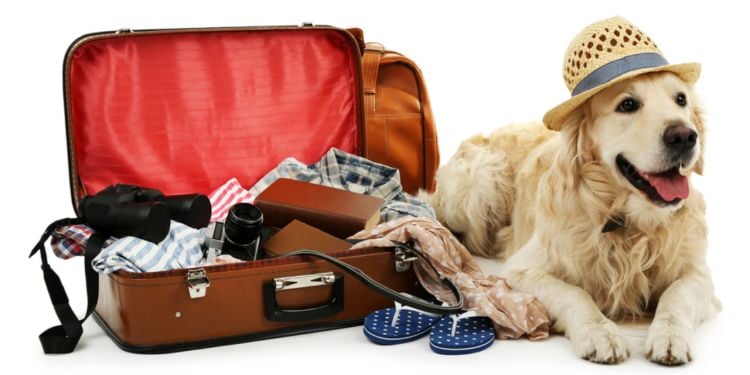Moving to Japan with your pet

You're ready to move to Japan and want your pet to accompany you on your new adventure, but what steps do you need to take to ensure that the trip goes smoothly for both of you? The MAFF (Ministry of Agriculture, Forestry and Fisheries) and IATA (International Air Transport Association) have valuable information on the procedure to follow, but you know, people keep all kinds of pets. This article will mention procedures to import the most common ones – dogs and cats.
Procedures for moving to Japan with your pet
Moving to Japan with your pets means you import them into Japan. Japan has specific rules for importing pets to ensure that only animals in good health are allowed into the country. The necessary documents you'll need to bring with you may differ based on where your pet is coming from, the type of animal, and the reason for travel.
Because your pet must undergo various medical tests and treatments to meet Japan's pet import rules, you should start preparing for your pet's journey to Japan at least 40 days before you leave.
Import dogs and cats to Japan
Your dogs and cats must undergo import quarantine to be imported into Japan. First, you must inform the Animal Quarantine Service (AQS) about your arrival plan, then apply for import inspection when you arrive. The animal quarantine officer will check the health certificate, physically examine the animal, and provide the import quarantine certificate.
Since August 1, 2023, AQS has recognized health certificates from the exporting country/region or those obtained through electronic records from the USA, Brazil, and Spain.
If the dogs and cats meet the import requirements upon arrival, the quarantine period will be within 12 hours. However, if they do not, they will be quarantined at an AQS detention facility for the necessary period, which can be up to 180 days. Depending on the outcome of the quarantine, you can bring them to Japan or not.
Essential steps before traveling to Japan with pets
The steps vary depending on the region you export your dogs and cats:
- designated areas: Australia, Fiji Islands, Guam, Hawaii, Iceland, and New Zealand;
- non-designated areas: others.
Below is what you should do before departure.
Step 1: Microchip your pets
A microchip is a form of identification for your dogs and cats. Every dog and cat coming into Japan needs a microchip that follows the ISO 11784/11785 standards. Currently, microchip numbers starting with "900 202" are being investigated for their validity and will not be accepted as a form of identification.
Step 2:
- For designated areas: Prepare proof of residency for your pets
Your dogs and cats must have lived in the region since birth or for at least 180 days before being taken to Japan. If not, your pets will have to undergo quarantine upon arrival in Japan to make up for the days they were not in the designated region.
- For non-designated areas: Vaccinate your pets against rabies and have your pet tested
After getting a microchip implant, dogs and cats must receive multiple rabies vaccinations. If the rabies vaccination's validity ends before reaching Japan, an extra immunization must be given within that timeframe. It's important to remember that in Japan, any vaccination given to pets under 91 days old is considered invalid.
Rabies antibody tests need to be done at a specific lab. The blood sample for the test should be taken after the second rabies shot or on the same day. The antibody level for rabies must be 0.5 IU/mL or higher.
Dogs and cats must enter Japan at least 180 days after the rabies antibody test. They must also arrive within the expiration date of the rabies vaccine and the two-year validity period of the antibody test.
Step 3: Inform AQS about your arrival plan
You must inform AQS at the designated port of entry at least 40 days before arriving in Japan. The notification form can be submitted via mail, fax, email, or NACCS. AQS will review the “Notification” and associated documents and issue an “Approval of Import Inspection of Animals”.
Step 4: Have your pets inspected by a vet
Before departure, a vet needs to check your dogs and cats and determine they are clear of rabies and the dogs don't have leptospirosis.
Step 5: Get an official government health certificate
You can get the form from the MAFF website. The certificate should have the pet's personal details, microchip number, and implantation date. It should also include information about the residence regulations and the result of the clinical inspection. Ask your vet to complete the form and get it approved by the government.
Once in Japan, your pet will be inspected by animal quarantine services. You will be responsible for the cost of this inspection. Once all the formalities are completed, you must register your pet with your municipality of residence in Japan.
Finding accommodation in Japan with your pet
As a long-term resident, finding a place in Japan that allows pets is important unless you buy a house in Japan. Different conditions for accepting pets include:
- Only dogs and cats are permitted (most other animals are not);
- Cats may not be allowed in some properties due to concerns about potential damage;
- The number of pets allowed may vary depending on the property, so checking in advance is necessary. If you have more than two pets, the options for rental properties that accept pets may be limited;
- The size of the dog can also affect acceptance. Very few properties allow medium-sized dogs. Some large dogs may be accepted if they have a calm demeanor and do not bark excessively;
- Certain dog breeds known for their gentle nature, like Labradors and Golden Retrievers, are more likely to be accepted.
You might have special terms and conditions in your rental agreements, such as an extra month's deposit, than those without pets. Additionally, you might need to provide certain documents when moving in, like pet tags and proof of rabies vaccination.
Regulations when keeping pets in Japan
When living with your pet in Japan, it's essential to consider your neighbors and the people around you. Not everyone in a pet-friendly apartment has a pet, and people may have different opinions about dogs and cats. When you move in, introduce yourself to your neighbors, tell them you have a pet, and regularly communicate with your neighbors. This can help prevent any issues related to your pet.
When taking them for a walk, always keep your dogs on a leash. Off-leash walking is not allowed. It's also polite to bring a dog poop bag and bottled water for cleaning up after your dog.
When you get around, trains are the most convenient way to travel, and many are pet-friendly. Here are the general rules to bring your pet on board:
- Only small pets in a carrier or bag are allowed on trains and they must stay inside the carrier or bag throughout the journey;
- You need to purchase a separate ticket for your pet;
- You must board and exit the train at designated pet-friendly carriages or areas.
The rules may vary depending on the train company and specific train line. To ensure that your pet is allowed and to learn about any additional rules or restrictions, it's best to check with the train company beforehand.
Another option is renting a car in Japan if you plan a road trip with your furry friends. This may cost a bit more, and you'll need a valid driver's license recognized in Japan. Additionally, there are specific guidelines regarding your pet's size and crate dimensions. Be sure to inquire with the car rental agencies for further information.
Useful links:









